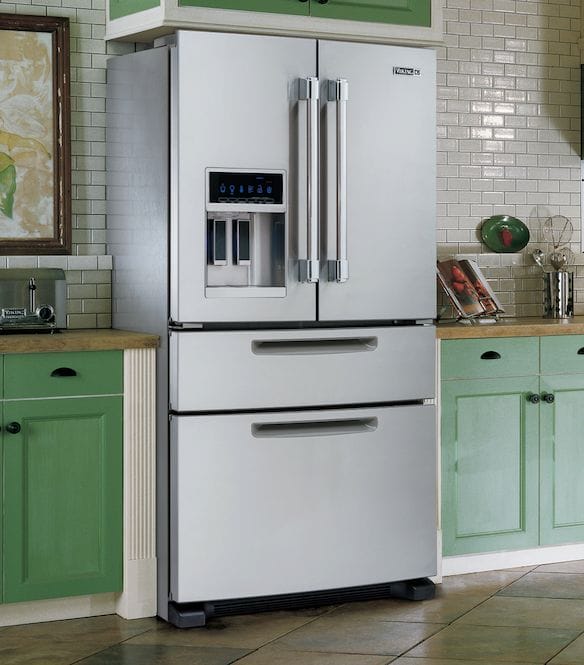
Image credit: Elite Appliance.
Buying Guide for Refrigerators
Refrigerators, like donkeys and elephants, live a very long time. Many of us know people who haven’t replaced their fridges since Ronald Reagan was president and are still satisfied with their fridges’ performance. The fact is, though, that refrigerators have come a long way since the 1980s. There have been massive improvements in their configurations, energy efficiency, and the kinds of tasks that they can perform beyond just keeping food cold or frozen. If you’re in the market for a new refrigerator, here’s how to choose the one that’s exactly right for you.
Tip #1 is easy. Be a measuring fool. Measure the space where your new fridge is going to go. Measure it again. Judge the clearances on all sides, where possible doors might open. Write down these dimensions in smudge-proof ink. There’s nothing worse getting your new fridge home and finding it won’t fit where you want it.
Tip #2 is easy too. How much capacity do you need? If you live like a New York City apartment dweller and keep only a little food in your fridge at a time, your needs will be much less than a family of eight that shops weekly at a “big box.” Generally, each adult in your household will merit about five cubic feet of space.
Once you’ve measured your space and figured out your storage capacity, you’ve got some decisions to make:
Where are the Doors?
Today’s refrigerators come with many different configurations. There are some that have the freezer on top (top-mount), some with the freezer on the bottom (bottom-mount), and some with side-by-side refrigerator and freezer doors. There are also “French door” refrigerators that have side-by-side, separately refrigerated compartments on the top, and a freezer unit on the bottom. With double “French doors” on top, you need only open one side of the fridge at a time.
The key here is your own comfort. You’ll want your most commonly used foodstuffs – milk, eggs, school lunch ingredients, and the like – at a level where you won’t need to bend. If you’re a consumer who often goes into your freezer, then it makes sense to have it above the refrigerator, or side by side. If your freezer is opened less than your fridge, you might well want to think about having it bottom-mounted. That way, you’ll only need to bend or kneel infrequently.
Storage Configurations
In the olden days of your parents’ refrigerator, there are limited options for how the interior of a fridge and freezer could be configured. You’d get some door shelves, some wire racks, maybe a crisper or two, and that was that. Today’s refrigerators are infinitely more flexible. Shelves can be moved up and down to fit your needs. Bin heights can be adjusted. Door shelving is of different widths – some shelves are wide enough to hold even a plastic gallon of milk. There are even fridges with wine racks, and special humidity and temperature controls for bins.
Again, think carefully about how you use your fridge. Some of these options may be indispensible to you. Some may be merely bells and whistles. You might be able to save money with a less sophisticated set of storage systems.
Ice and Water
No one is ever sorry to have purchased a refrigerator with an ice maker. The hassle of messing around with ice trays goes away when there are always cubes in your freezer. While a freezer with an icemaker does add some cost, that icemaker is one of those things you will find yourself using all the time. Get one if you can afford it. Many refrigerators also offer front-door water and ice dispensers. Some of these water systems are even filtered. You could save money in the long run by buying such a system, particularly if yours is a household where bottled water is consumed.
Energy Efficiency
High-efficiency refrigerators aren’t just good for the planet, they’re good for your pocketbook. The latest “Energy Star” refrigerators are those certified to use no more than 80% of the federal standard for refrigerator electrical consumption. They carry a prominent Energy Star label that touts their energy efficiency.
Conclusion
In addition to the foregoing, you also might want to listen to your possible new fridge in action in a quiet location. The low drone or buzz of some refrigerators can be distraction. Finally, if you’re a person who likes to attach photographs to the front of your fridge? Some models now come with digital photo displays. No more tape or magnets needed!



